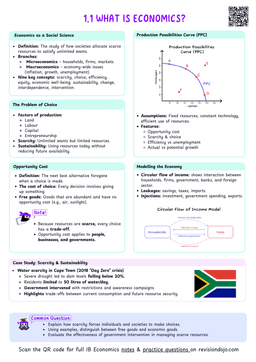In classical economics, firms are assumed to be profit maximisation seekers. However, firms may have alternative business objectives:
- Corporate social responsibility.
- Market share.
- Satisficing.
- Growth.
Try to memorise case studies that can be applied to more than one concept!
Profit maximisation: the traditional objective
Rational Producer Behaviour
The act of aiming to maximise profits. The goal of firms, according to the standard theory of the firm.
Profit as factor payment
Payments, per unit time, made to the owners of entrepreneurship (one of the factors of production)
Profits can also be understood as the difference between the total revenue and costs of a firm.
- Profits can be understood as the difference between the total revenue and costs of a firm.
- Hence, profit maximising firms try and maximise how much they earn while minimising how much they spend.
- The idea that firms seek for profit maximisation is a key assumption in traditional economic models.
- However, real-world firms often pursue other objectives.
Profit maximisation in action
Suppose a firm produces 10,000 units of a product $X$ that
- Costed $\$ 50,000$ in total.
- Sold 9000 units for $\$ 10$ each.
Then the total revenue earned is
$$ 9000 \times \$ 10 = \$ 90000 $$
So the profit is
$$ Revenue - Cost = \$ 90000 - \$ 50000 = \$ 40000 $$
Alternative Business Objectives
Corporate social responsibility
Corporate social responsibility involves firms adopting ethical practices that benefit society as a whole, rather than focusing solely on profits. Firms may make business choices with their corporate social responsibility in mind due to:
- Reputation and brand loyalty: a firm’s image, attracting socially conscious consumers.
- Long-term profitability.
- Employee satisfaction.
- Regulatory Compliance.
- Lowers the chance of stricter government intervention.
Due to the increasing environmental and ethical awareness of consumers, firms find the impact of corporate social responsibility to be higher nowadays.
Case studyPatagonia. Prioritizing Environmental Sustainability Over Profit Maximization
Patagonia, the outdoor clothing and gear company, is renowned for its commitment to environmental sustainability. Instead of focusing solely on profit maximization, the company prioritizes environmental and social goals. For example, Patagonia encourages customers to repair and reuse their clothing rather than purchase new items, even offering free repair services and guidance. This approach deliberately limits sales growth to align with its sustainability mission.
Non-Profit Maximizing Objectives:
- Patagonia donates 1% of its sales to environmental causes and reinvests in sustainable materials and ethical labor practices.
- By focusing on sustainability, Patagonia builds strong customer loyalty, which can have long-term benefits even if it reduces short-term profits.
Outcomes:
- The company's "Don't Buy This Jacket" campaign, encouraging mindful consumption, resulted in increased brand loyalty but also paradoxically led to higher sales due to strong brand alignment with customer values.
- Patagonia’s practices demonstrate that prioritizing environmental sustainability can coexist with financial success, even if it doesn’t strictly maximize short-term profits.
Market share
Market share
The percentage of total sales in the market, which a firm is part of, that the firm generates.
For an industry that had total sales of $\$ 10$, if a company in that industry had sales worth $\$ 5$ then its market share is $50\%$


